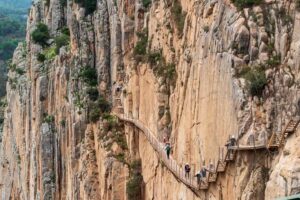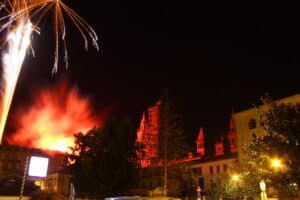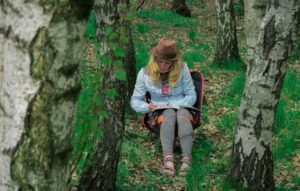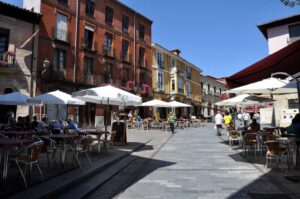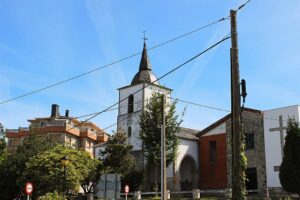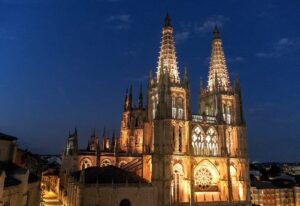El Road to Finisterre is known as Jacobean extension: Epilogue to the Camino de Santiago. This is the only one that actually has the Cathedral of Santiago as its starting point.
Our company to do the Camino de Santiago consider that this path has its own entity. Those who reach what one day was for our ancestors “The end of the world” will be able to obtain the certificate of “La Fisterrana”, and if you also reach Muxia you will get the certificate “the Muxiana”
El Finisterre path it is also very old, even older than Christianity. There is evidence that the pagans made the way to Fisterre. They believed that the sun died there and the worlds of light and darkness met at the same time.
Índice de contenidos
Origin and history of the Camino a Finisterre
This is one millennial route loaded with magical enclaves with legends of lost towns and esoteric rites. If you want to cross this path you will get to know the most fascinating popular culture of Galicia.
The origin and primitive history of this place is not very well documented. It is said that, in ancient times, Finisterre (or Finis Terrae, as the Romans called it) was thought to be the westernmost point in the world. That’s why, they call him the end of the known earth. It was believed that beyond the peninsula formed by Cape Finisterre there was nothing.
In this way, they were encouraged to build in that enclave an altar in honor of the star king. Here they worshiped the sun, prayed and made thanksgiving offerings to the gods. They also practiced various rituals, many related to fertility.

History of the name of “Costa Da Morte”
The origin of the Costa da Morte has also been mentioned, which was related to the belief that the Camino Finisterre led to the end of the world. Regarding the name of Costa da Morte or three existing theories, of which two refer to this fact:
- One theory holds that the name is because on the coast the sun died.
- Another points out that it is associated with the term “the death of all known land“
- The third stream defends that the origin of the name is due to the high mortality of sailors that was recorded in the seas.
Where does the Camino a Finisterre start?
This route does not lead to Santiago de Compostela, but it leaves from this place. The Camino de Finisterre has two possible destinations: the finisterre lighthouse, located 88 kms, or the Sanctuary of A Barca in Muxía which is located about 82 kms.
Many pilgrims when they arrive in Santiago decide to continue and start the journey in the old “finisterrae”. There they can contemplate the bravery of the Ocean from the Cape. Besides, they burned some garment that they carry on the pilgrimage as a symbol of renewal (now it is forbidden to burn clothes, under a fine)
Route of the Camino to Finisterre and main cities
This is a short-distance road, a little over 88 km, which is divided into 5 marked stages, like the other Jacobean roads.
This is considered the second most popular pilgrimage route. The data recorded in the accommodations on the Camino de Finisterre-Muxía and in the entities that issue pilgrimage certificates indicate that the number of pilgrims increases year after year.

Stage 1: Santiago de Compostela – Negreira (20,6 km)
This first stage runs through the Santiago town hall. Start at the Obradoiro Square, between the Raxoi palace and the Hostal de los Reyes Católicos. Once there, you go to Calle de las Huertas.
Then continue on Pombal and Poza de Bar to the oak grove of San Lourenzo. Here you get the first official indicator of the route. There is news of this oak grove since ancient times. Among the oaks we can see the wall that surrounds the convent of San Lourenzo de Trasouto, which was converted into a palace in the XNUMXth century.
The first stage of the Camino to Finisterre and Muxía It’s very comfortable. From Santiago de Compostela you will be able to see beautiful rural landscapes, pines and eucalyptus trees. Before reaching Negreira You find Put on maceira, one of the most beautiful towns in Spain.
In addition, you will cross the glorious stone bridge to admire the passage of the river tambre and enjoy the architecture of their houses.
Stage 2 and 3: Negreira – Maroñas – Olveiroa (32,6 km)
This is one of the hardest stages, since it is a rural environment full of steep slopes and unevenness. In addition, it is the longest journey of all those that make up this route.
The first 13 kilometers to Vilaserío progresses by lush forests. In addition, the slope is generally positive, so it is quite a leg-breaking section. While the next eight kilometers to Santa Marina they are softer and it is a clearer territory.
Likewise, the last section is the descent of the Mount Aro. You will see beautiful views of the Xallas Valley and the Fervenza reservoir.
Stage 4: Olveiroa – Cee (17,9 km)
The imposing xallas river presides over the beginning of this stage. This route takes us near the sanctuary of Nosa Señora das Neves and the top of O Cruceiro da Armada.
We left Olveiroa to contemplate the impressive Xallas River, which flows through lush vegetation. This is how you cross the river Hospital to enter O Logoso and then the village of Hospital. Later on, the roundabout that divides the paths to Fisterra and Muxía appears.
Then comes a marked descent that offers views of the Corcubion estuary.

Stage 4: Cee – Corcubion – Finisterre (15,2 km)
Cee is the largest municipality on the Costa da Morte. The center of the town is reached through Campo Sacramento and Rúa Magdalena.
very close is Corcubion, which preserves an old town that was declared a historical-artistic complex. While for the Rua San Marcos you arrive at the beautiful homonymous church, built in the Gothic-marine style at the end of the XNUMXth century.
And so we reach the last stage that includes from Corcubion to Finisterre.
The town of origin has a Celtic settlement of which some remains are preserved in the castro del Mount Quenxe and that offers magnificent views over the estuary. In this town you can visit the San Marcos Church, the Pazo de los Condes de Altamira, the Pilar Chapel, the Cardenal Castle and the José Carrera building.
Finisterre is a point on the planet considered for centuries the end of the world, the place where the sun set behind the dark waters of the Atlantic Ocean.
It currently has about 5.000 inhabitants, is made up of Fisterra, as the main nucleus, and various neighboring parishes. It is a clear example of a fishing village, where you can see the port and the market. This is an area prepared for tourism.
This route is an option for those pilgrims who want to travel near the coast and a route less traveled than the famous French Camino de Santiago from Sarria.

